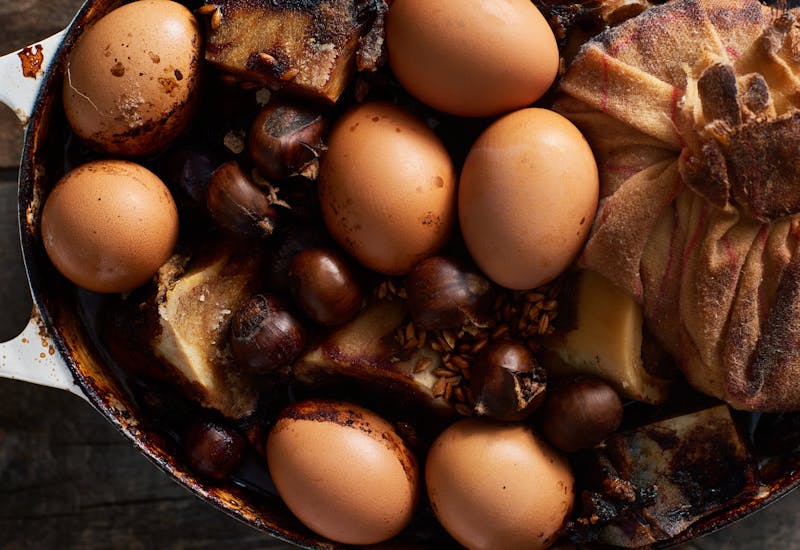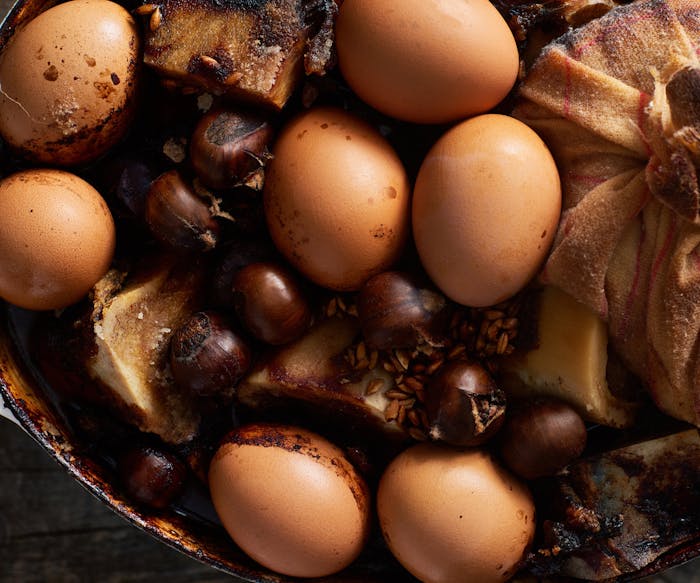When Tziona Abramov, an eighth generation Jerusalemite was growing up in the 1950s, the cholent in her home was nearly identical to the ones served in her neighbors’ homes. On cold winter weekends, her father Moshe, a second generation butcher, would lay a mix of chickpeas and white beans on the bottom of a large dish, top them with beef and potatoes, kishke, and rice in a separate pouch, to make the little known Jerusalem cholent.
“My grandmother was mixed,” she explained. Her mother’s family came from Morocco and her grandfather from Russia, but, as Tziona puts it, this cholent was “the tradition in Jerusalem.”
For the uninitiated, cholent or hamin, as it’s called in many Sephardic homes, is a staple of the Jewish canon. A mix of beans, potatoes and sometimes rice, various cuts of meats, and often eggs, the dish is beloved by Jewish communities from Eastern Europe to the Levant, adapting itself well to local flavors and ingredients. Thought of as the quintessential dish of Shabbat lunch, it benefits from a long, slow cook that happens over the evening of Shabbat, making the pot ready just in time for a hardy mid-day meal.
In Tziona’s family, that meal remained even during the years of austerity, early in the state’s development, when food, particularly meat and eggs were scarce. Much of the food in their home came from a bartering system, a type of black market Moshe was a part of. If a customer couldn’t pay for their meat with cash, they would pay in eggs, or whatever they could. “Everyone knew him when Jerusalem was still smaller,” Anat, Tziona’s daughter and a contributor to the Jewish Food Society explains. “He was a man of a lot of stories,” but not always accurate ones, Tziona jokes.
Moshe would tend to the cholent, going to the kitchen often during the night and early morning to check the flame hadn’t gone out (and to sneak a taste). In the morning, he would fish out the eggs for an early morning meal of egg and chopped vegetable salads and fresh challah, saving the rest for lunch. It was a recipe and tradition he inherited from his mother Tzipora, who would take her pot of cholent to a neighborhood bakery before shabbat to tuck it into a large communal oven, retrieving it before the sunset and allowing it to stay warm over a low light appliance that the family used especially for the dish. Jerusalem cholent, according to Sherry Ansky’s wonderful Hebrew-language book Hamin, is marked in part by influences from the many cultures of Jewish families that settled in the city, who may have shared recipe secrets while at the bakery or simply in the courtyards that dot parts of the city.
In 2018, Jerusalem cholent is in danger of fading, or at least being forced to change. “I’m not cooking cholent at all now,” Tziona explains. “I cannot get the kishke.” Anat hops in to add that the intestines that are traditionally used to make kishke are no longer allowed to be sold in Israel, and have been replaced with something synthetic. Tziona, who used to get her kishke from a local orthodox family until they stopped making it, refuses to compromise with the new product.
Anat, however, started to experiment with making kishke without casing in her Tel Aviv home, even trying it out on her mother, who approved, saying: “I loved what you did.” Despite the compromise she had to make to the recipe to keep it going, Anat says she is glad she did. Adding that she couldn’t give up the cholent and the atmosphere it created, of friends and family all gathered around the table, sharing the dish.

